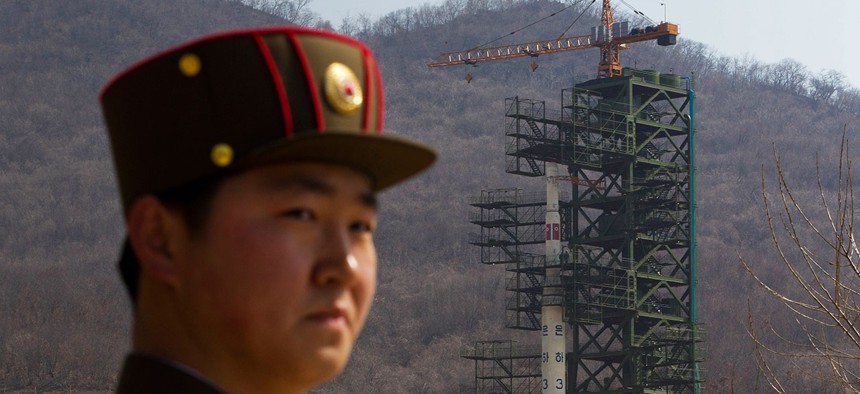
A North Korean soldier stands in front of the country's Unha-3 rocket, slated for liftoff between April 12-16, at a launching site in Tongchang-ri, North Korea on Sunday April 8, 2012. North Korean space officials have moved a long-range rocket. David Guttenfelder/AP
What ‘Missile Engine Testing Site’ Is Trump Talking About?
It’s unclear. But experts say it also doesn’t really matter: it’s unlikely to much affect North Korea's nuclear capabilities.
North Korea will destroy an engine-testing site as part of its denuclearization process, U.S. President Donald Trump told reporters Tuesday after his meeting with Kim Jong Un in Singapore. “Chairman Kim has told me that North Korea is already destroying a major missile engine testing site,” Trump said. “We agreed to that after the agreement was signed. That’s a big thing, for the missiles that they were testing. The site is going to be destroyed very soon.”
But Trump didn’t name the “engine test site” and it’s not clear what he was talking about. More importantly, experts say the removal of any one testing site is unlikely to hamper North Korea’s ability to make nuclear weapons.
Perhaps it was the Iha-ri Driver Training and Test Facility, which the North Koreans are already razing. Jenny Town, managing director of the open-source intelligence site 38 North, said Iha-ri Driver was “as educated a guess as any.”
That site helped develop the solid-state rocket engine for the Pukguksong-2 mid-range ballistic missile, but there’s no reason to believe its destruction indicates the abandonment of any future tests or programs, said Dave Schmerler, a research associate at the James Martin Center for Nonproliferation Studies.
“The dismantlement of the Iha-ri ejection test stand seems to reflect the progress made in the Pukguksong-2 program, rather than it being connected to any other notional canister launched missile system. If we see a new test stand appear near a vehicle manufacturing site, it might indicate that the North Koreans are working on a new system, however there is no indication of this at the moment,” he said.
But Middlebury researcher and arms control watcher Jeffrey Lewis said that site doesn’t really qualify as an engine test site.
“North Korea has multiple engine test stands. The one at Hamhung is a concrete block with a roof over it. It is a good thing if North Korea refrains from static engine tests, but that won't prevent North Korean from producing more missiles. And North Korea could easily resume testing,” Lewis said. Bottom line, he says: “North Korea does not need to conduct further static engine tests to continue to produce existing missile systems."
The Iha-ri facility played an important role in the North’s continued development of solid-state engines. The North Koreans began testing engines there in February 2017.
In his 38 North piece, Joseph S. Bermudez Jr. wrote that the North began to raze the site after Kim announced that his regime would cease all ballistic missile tests. The work began last month and was mostly done by May 19.
How important is the facility? Bermudez described it as useful for testing canister-based solid-state medium-range missiles. Such engines burn potassium nitrate or another solid propellant rather than more finicky liquid fuels such as hydrogen, making them more stable, easier to prepare for launch, and simpler to make. If it hadn’t been razed, the site might have been used, say, to convert North Korea’s liquid-fueled Hwasong-15 ICBM to solid fuel.
Whichever missile it is, Town agreed that the concession is largely moot. “North Korea has also said it is done with the development phase of its nuclear and missile systems, so these measures are still largely symbolic diplomatic gestures and do not affect the core of NK’s nuclear capabilities,” she said.







